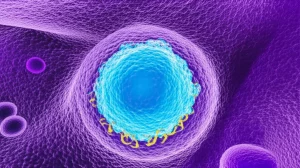Eczema, Eye Lenses, and a Protein Problem: What You Need to Know
Hey there! Let’s chat about something that might sound a bit niche, but it’s actually super interesting, especially if you or someone you know deals with atopic dermatitis, that common skin condition often called eczema. We’re diving into how this skin issue might connect to something happening deep inside your eye after cataract surgery – specifically, the artificial lens moving out of place.
You see, cataract surgery is pretty standard these days. They take out your cloudy natural lens and pop in a clear, artificial one called an intraocular lens (IOL). Most of the time, it stays put, nestled nicely in what’s left of your old lens’s little pocket, the capsular bag. But sometimes, months or even years later, that IOL decides to go on a little adventure and dislocate. It’s not super common, but it happens, and the numbers might even tick up as surgery techniques get better and more people get IOLs.
The Eczema Connection to Eye Troubles
Now, why would an itchy skin condition have anything to do with your eye surgery? Well, atopic dermatitis (AD) isn’t just skin deep. It’s linked to a whole bunch of other health issues, including eye problems. We’re talking cataracts, retinal detachment, glaucoma – serious stuff that can really mess with your vision, especially for younger folks.
When it comes to IOL dislocation in people with AD, it gets a bit puzzling. Sometimes the whole capsular bag shifts (that’s capsular bag dislocation or CBD), possibly because the little fibers holding it in place (the zonules) get weak, maybe from all the rubbing and scratching that can come with itchy eyes in AD. But then there’s this other weird type called dead bag syndrome (DBS), where the bag looks surprisingly clear and doesn’t seem to have the normal healing or scarring (fibrotic changes) you’d expect years after surgery. The reasons for these different types in AD have been a bit of a mystery.
I’ve heard about how in AD cases, the cells lining the lens (lens epithelial cells or LECs) can look a bit off, and the lens capsule itself might not scar up properly. There’s even a specific issue called capsular splitting that seems more common in AD, regardless of the dislocation type. This hinted that maybe AD itself is making the lens capsule fragile.

Enter the Protein Culprit: MBP
So, what could be causing this fragility in AD eyes? Scientists have been looking at a protein called eosinophil major basic protein (MBP). This protein comes from immune cells called eosinophils, which are often involved in allergic and inflammatory conditions like AD. High levels of MBP have been found in the fluid inside the eye (the aqueous humor) of AD patients, and it’s thought that MBP can damage those lens epithelial cells (LECs). This damage has been linked to cataract formation in AD.
The big question was: Is this same protein, MBP, also involved in making the lens capsule weak and causing IOL dislocation in AD? That’s what a recent study set out to investigate.
What the Study Did
Imagine looking at the actual lens capsules taken out during surgery from people who had IOL dislocations. That’s what these researchers did. They looked at samples from 22 eyes – 10 from patients with AD and 12 from patients without AD (NAD). They specifically looked at parts of the lens capsule complex that remain after surgery, like the Soemmering’s ring (a donut-shaped structure formed by leftover LECs and capsule) and areas of fibrous metaplasia (where cells change and create scar-like tissue).
They used a special staining technique (immunostaining) to see if MBP was present in these tissues and how much there was. They measured the amount of staining using something called the staining area ratio (SAR) gap, which basically tells you how much more staining there is compared to a control sample.
What They Found: The Key Discovery
Here’s where it gets interesting. When they looked at the Soemmering’s ring, they found significantly higher levels of MBP staining in the AD group compared to the NAD group. It was like, wow, there’s a lot more of this MBP protein hanging around in the eyes of AD patients who had dislocation! This strongly suggests that MBP might indeed be playing a role, potentially continuing to weaken the lens capsule structure even after the original cataract surgery.
What about other areas? They didn’t find MBP staining on the lens capsule itself or on the LECs in *any* of the samples they looked at in this study. This was a bit different from previous studies that *did* find MBP on LECs in AD cataracts. The researchers think this might be because most of the LECs and the front part of the capsule are removed during the initial surgery, and the remaining cells might have degenerated over time, especially if they were exposed to MBP.

They also looked at fibrous metaplasia areas. While some cases in *both* the AD and NAD groups showed some MBP staining in these scar-like tissues, there wasn’t a significant *overall* difference between the two groups. Interestingly, some NAD cases with MBP staining had histories of trauma or unknown causes for dislocation, and some showed a specific type of less dense scarring (low-density fibrosis or LDF) that’s often seen in AD cases. This makes you wonder if maybe some of those NAD cases might have had undiagnosed AD or a similar inflammatory process going on.
Piecing Together the Puzzle
Based on these findings and previous research, the researchers propose a hypothesis: MBP toxicity might be causing ongoing damage to the lens epithelial cells (what they call “Lens Epitheliopathy”). Since these cells are crucial for maintaining the lens capsule and for the normal healing process (like forming fibrosis through epithelial–mesenchymal transition or EMT) after surgery, damage to them could make the capsule weak and fragile. This fragility could then lead to the IOL dislocating, potentially explaining both the general fragility seen in AD dislocations and maybe even the mysterious DBS where the bag seems too clear and not properly scarred.
Think of it like this: the LECs are supposed to help repair and maintain the capsule. If MBP is constantly irritating or damaging them, they can’t do their job properly. The capsule, which is essentially the basement membrane produced by these cells, gets weak, and the normal post-surgery scarring/healing doesn’t happen as it should.

Why This Matters for the Future
So, why is this important? Well, if MBP is confirmed to be a key player in AD-related IOL dislocation, it opens up exciting possibilities. MBP could potentially be used as a biomarker – something doctors could measure (maybe in the fluid of the eye or even the blood) to identify AD patients who are at a higher risk of their IOL dislocating after surgery.
Knowing who’s at high risk means doctors could potentially intervene. This might involve trying to control MBP levels with medication or even choosing a different surgical approach during the initial cataract surgery that doesn’t rely on the potentially fragile capsular bag to hold the IOL.
A Few Caveats
Now, like any good study, this one has its limits. It was a relatively small group of patients, especially the rare DBS cases. They also didn’t measure the actual MBP levels in the eye fluid, only looked at staining in the tissue, so we don’t know if the amount of protein in the fluid directly relates to what they saw in the tissue. Plus, because they looked at samples *after* the dislocation happened, they can’t definitively say if the MBP caused the dislocation or if its presence is somehow a result of the dislocation process itself (though the hypothesis leans strongly towards it being a cause).
Wrapping It Up
Despite the limitations, this study gives us some really cool new insights. It’s the first time, as far as they know, that researchers have looked at the link between MBP and the specific pathology of the lens capsule in AD patients with IOL dislocation. The finding of higher MBP in the Soemmering’s ring of AD cases is a strong clue.
It suggests that MBP isn’t just involved in forming cataracts in AD; it might continue its mischief after surgery, contributing to the unique fragility of the lens capsule complex and increasing the risk of IOL dislocation. It’s a step towards understanding a complex problem and potentially finding ways to prevent it in the future for people with atopic dermatitis.
Source: Springer







